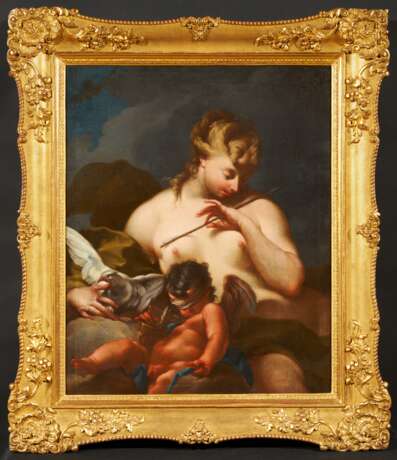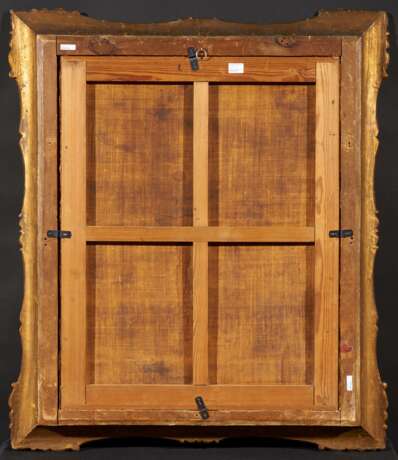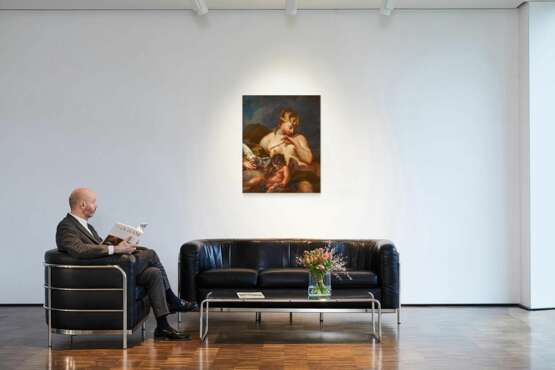ID 1072403
Lot 1232 | Giovanni Battista Pittoni. Venus mit dem schlafenden Amor
Valeur estimée
€ 20 000 – 30 000
Venice 1687 - 1767
Title: Venus mit dem schlafenden Amor.
Technique: Oil on canvas.
Mounting: Relined.
Measurement: 95 x 75cm.
Frame: Framed.
Provenance:
Private ownership, Austria.
At first glance, this is a very classical antique subject: Venus and her son, the winged little Cupid, are reclining on a cloudy ground. A dove, attribute of the goddess of love, is also present. The background is a diffuse grey cloudy sky, blue in the upper left corner of the picture. The whole scene is compact and of a calm unity. There is no interaction, no scenic narrative.
All the more reason to take a second look: Venus has taken an arrow from Cupid's quiver. She clearly holds it in front of her chest. According to mythology, Cupid, blinded by the blindfold, had two arrows in his quiver. One with a golden tip: whoever is hit by it will be inflamed with love. The second arrow has a lead tip. If Cupid shoots it, the victim will close himself off to earthly love. The disaster to which the use of both arrows can lead is known from the story of Apollo and Daphne.
The arrow that Venus holds up here does not shine golden against the dark background. It is the one with the leaden tip. There is also only one dove in the picture and not, as usual, a pair of cooing doves. The left wing of the bird is bent. Thus it will no longer be able to fly to a mate. Renunciation of earthly love is the actual theme of the picture.
Cupid, whose skin is coloured red by the glow of love, points with his two hands in different directions, allowing some interpretation here. The index finger of his right hand points upwards - to heaven? With his left hand he points out of the picture - towards the viewer? Is the leaden arrow meant to strike the viewer so that he turns not to earthly love but to heavenly love?
Giovanni Battista Pittoni, who created this multi-layered painting, was one of Venice's most celebrated painters in the 18th century. He was trained by his uncle, the painter Francesco Pittoni, and at the age of 29 he became a master member of the Venetian painters' guild. Venice at the beginning of the 18th century was a gathering place of highly talented artists who influenced each other but also competed with each other. Thus Giovanni Battista Pittoni engaged with the art of the somewhat older Sebastiano Ricci as well as with his artist colleague Giovanni Battista Piazzetta, who was about the same age, and the somewhat younger Giovanni Battista Tiepolo. This fruitful competition shaped the Venetian Rococo.
Giovanni Battista Pittoni quickly gained the greatest recognition with his historical, mythological and religious paintings, often in very large formats, and was immensely productive. He became an honorary member of the Accademia Clementina di Bologna and prior of the Collegio dei pittori di Venezia. He was also a founding member of the Accademia di belle arti di Venezia, and for a time its president.
Unlike many Venetian artists, Pittoni probably travelled little; he produced many altarpieces for churches in Upper Italy and the Veneto. Nevertheless, he was one of the masters most in demand by foreign collectors and princely courts. Orders came from all over Europe and Pittoni painted the requested canvases in Venice, which were then sent to courtly and ecclesiastical patrons in Austria, Poland, Russia and "Germany".
Today Giovanni Battista Pittoni is represented with paintings in many international museums and collections as one of the most outstanding representatives of the Venetian Baroque.
We are grateful to Enrico Lucchese, Trieste, for confirming the attribution of the present painting on the basis of a high-resultion digital photograph.
| Artiste: | Giambattista Pittoni (1687 - 1767) |
|---|---|
| Technique appliquée: | Huile |
| Catégorie maison de vente aux enchères: | Vieux maîtres |
| Artiste: | Giambattista Pittoni (1687 - 1767) |
|---|---|
| Technique appliquée: | Huile |
| Catégorie maison de vente aux enchères: | Vieux maîtres |
| Adresse de l'enchère |
VAN HAM Kunstauktionen GmbH Hitzelerstr. 2 50968 Köln Allemagne | ||||||||||||||
|---|---|---|---|---|---|---|---|---|---|---|---|---|---|---|---|
| Aperçu |
| ||||||||||||||
| Téléphone | +49 221 92586215 | ||||||||||||||
| Fax | +49 221 92 58 62 4 | ||||||||||||||
| Commission | 32% | ||||||||||||||
| Conditions d'utilisation | Conditions d'utilisation | ||||||||||||||
| Heures d'ouverture | Heures d'ouverture
|








